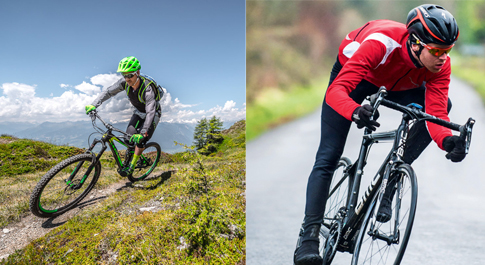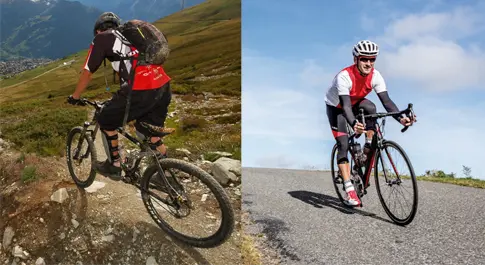Biking and cycling are two very popular methods of transportation. Both bikes and cycles have advantages and disadvantages depending on their use. Some key differences can help you decide which is right for you. Biking is typically faster than cycling, as you can pedal more quickly without worrying about balance.
Biking requires less effort than cycling, as you are not fighting against gravity to move forward. Biking can be more dangerous than cycling, as you are more exposed to traffic and other hazards. Biking can be challenging in specific terrains, such as hills or rough roads.
Cycling is a great way to get some exercise while still being able to travel at a decent speed. It is much easier on your joints than biking, as the pedaling motion is much gentler. Cycling can be slower than biking due to the need to balance on the bike.
Whether to bike or cycle depends on your individual needs and preferences. Throughout the full content below, we shared answers to all the possible questions that might arise in your mind and what you should know.
Biking vs Cycling: The Conceptual Difference

The main difference between biking and cycling is the type of bike that you use. Biking generally refers to riding a mountain bike or a BMX bike, while cycling refers to riding a road bike. Road bikes are designed for speed and efficiency, typically lighter than mountain bikes.
Learning about cycling vs biking can help you stay safe on the road. Both activities have risks, but being aware of those risks can help you avoid accidents. Reading about this topic can help you become a more knowledgeable rider.
The more you know about bikes and cycling, the more enjoyment you will get from both activities. So whether you are looking to get a new bike or simply want to stick to cycling, reading about biking vs cycling is an essential step.
The effort of cycling may be greater than biking, but it is also more efficient in calorie burn. Cycling is a competitive sport, whereas biking is a leisure activity.
Cycling may be a more appropriate option if you are looking for a workout that will challenge you physically and mentally. Biking is an excellent choice if you are simply looking for an enjoyable way to explore the outdoors.
Bicycling, also called biking, uses bicycles for transport, recreation, exercise, or sport. People engaged in cycling are referred to as “cyclists,” “bikers,” or less commonly, as “bicycles.”
Besides two-wheeled bicycles, “cycling” also includes riding unicycles, tricycles, and quadricycles. Bicycle racing is a competition sport in which various types of bicycles are used.
The term “bike” is sometimes used colloquially to refer to a bicycle or a motorbike. This article focuses on bicycling as a means of transportation, recreation, and sport.
Cycling vs Biking: Advantages
The benefits of both biking and cycling need to consider when deciding which is best for you when it comes to determining which one is better for you. If one considers the cost of spare parts and components, cycling can be a much more affordable option than buying a car.
If you choose to cycle instead of biking, you will save money in the long run since cycling requires less maintenance than biking. Cycling is a great workout that won’t break the bank if you are looking for something that isn’t going to cost you a fortune.
Biking
- When it comes to exercise that will keep you fit and provide you with a low-impact but still challenging workout, biking is an excellent option.
- As an excellent way to enjoy the outdoors, cycling is also a good choice for those seeking a healthy way of living.
- A bike may be a better option when exploring the outdoors or looking for a fun way to do so.
- Biking has several benefits, including improving your heart health and providing a great cardio workout.
- Biking is an excellent way to experience the natural environment and get fresh air. It is also a great way to spend time with family and friends. You should choose biking as a leisure activity that can provide you with many health benefits in addition to being a fun activity.
- Besides being a great way to keep fit, biking is also an excellent way to reduce stress and improve your mental health. In recent studies, it has been demonstrated that regular cycling can be beneficial in reducing anxiety and depression and improving cognitive abilities. There are so many benefits to biking. Biking is an excellent option whether you want to get in shape or boost your mood.
Cycling
- The main advantage of cycling is that it is a more efficient workout. Cycling is a great way to challenge yourself physically and mentally. Cycling may be the better option if you are looking for a movement activity that will burn more calories.
- Cycling puts a lot of strain on your legs and can be very hard on your knees, whereas biking is a low-impact exercise that is easy on your joints.
- Those looking for a competitive sport that they can compete in both physically and mentally might be best served by cycling as it offers both physical and mental challenges.
Biking vs Cycling: Disadvantages
Though there are many advantages to biking and cycling, some disadvantages should be considered.
Biking
Biking is often hailed as a green and healthy form of transportation, but it also has its drawbacks. One of the biggest problems with biking is that it can be hard to find a safe place to ride.
Bike lanes are often narrow and cluttered with dust, which can be dangerous for cyclists forced to share the road with cars.
Bikes are more vulnerable than cars, riding impractical or unsafe in some places. Bikes can be stolen or damaged, leaving riders stranded.
Cycling
While cycling has many advantages, several disadvantages should be considered before using this mode of transportation.
Cycling can be dangerous, particularly in traffic, as it is much smaller than cars and motorcycles, making it difficult for drivers to see. This can lead to severe accidents, especially if cyclists are not following the road rules.
Cyclists are vulnerable to weather conditions like rain and snow, making for a cold and uncomfortable commute. Cyclists are at risk of being hit by cars or trucks.
How to choose the right type of transportation for you?

Whether you are commuting to the office or exploring the great outdoors, you must choose the right type of bike cycle as your mode of transportation to ensure that your ride is safe and enjoyable. As you consider whether or not to decide to pedal over biking, it is vital to keep the following things in mind:
- It begins with: What would you say if you were to describe your fitness level? If you’re not in good shape and want to exercise, cycling may be better than biking since biking requires more upper body strength.
- The second part: There is no doubt that biking is excellent if you will be riding primarily on flat terrain. Cycling is probably a better choice if you depend on the hilly or mountainous terrain you will experience on the ride.
- The third step. Are you planning on spending a certain amount of money? It has been found that bikes are usually more expensive than cycles, so if you are on a tight budget, you may want to choose a cycle instead of a bike.
The fourth is: When it comes to your ultimate goal, what do you want to accomplish? The benefits of biking are numerous, such as the fact that you can enjoy a leisurely ride or use it for commuting purposes.
There are many benefits to cycling, but if you like to do intense workouts or if you’re looking to compete in races, this is probably not the best activity for you.
When you choose between biking and cycling, you’ll find that these things will help you make the right decision, and you’ll be able to choose the proper transportation for you.
Biking vs Cycling: Their History
Biking and cycling are popular forms of transportation and recreation, but they have different histories. Biking began as a way to travel faster than walking, and early bikes were often little more than modified wagons. Cycling, on the other hand, originated as a competitive sport, and early cycles were very different from today’s bikes.
The History of Bike
In the 1970s, a new type of bicycle began to gain popularity among adventurous cyclists looking for a more challenging ride; when cyclists began modifying cruiser bikes for use on off-road trails.
These “mountain bikes” were designed for riding on rough terrain, and they quickly became popular with riders looking for an adrenaline-filled experience. Today, mountain biking is a widely enjoyed sport, even professional mountain bike competitions.
Although mountain biking has come a long way in the past few decades, it has its roots in the early days of cycling. In the late 19th century, “adventure cycling” became popular, and riders began exploring more rugged terrain.
These early explorers soon realized that their bicycles were not well suited for the rough conditions, and they began to modify their bikes to handle the challenges of off-road riding better.
These early modifications laid the foundation for the modern mountain bike, and they continue to influence the design of today’s bikes. Early mountain bikes were modified road bikes with wider tires and stronger brakes, but over time they have evolved into specialized machines with features such as suspension.
The origins of the mountain bike are often debated. Some say that early mountain bikes were simply modified road bikes designed to handle the rigors of off-road riding. Others suggest that the mountain bike was inspired by earlier “clunker” bikes, which were created for use on steep, rugged trails.
Whichever story is true, it’s clear that the mountain bike has come a long way since its inception. Today’s mountain bikes are specialized machines designed to tackle even the most challenging terrain.
From lightweight cross-country bikes to burly downhill rigs, there’s a mountain bike to suit every type of rider. And with technological advances like full suspension and hydraulic disc brakes, today’s mountain bikes are more capable than ever.
The History of Cycle
The first regular bicycles were called boneshakers because of their wooden frames and iron wheels. They were not exceptionally comfortable to ride, but they improved over the earlier hobby horses, ridden like a horse with the rider sitting on a saddle and steering by holding the reins.
Boneshakers quickly became popular, and by the 1870s, they had evolved into the high-wheeled bicycles known as penny farthings. These bikes had a large wheel in front and a smaller wheel in the back, and they were pedal-driven.
During the 1880s, when safety bicycles were introduced, they fell out of favor due to their instability and difficulty in riding, which made it hard for cyclists to use them. There are two equally sized wheels on bicycles with safety wheels and a chain drive, which makes it easier for people to ride a bicycle with safety wheels.
They quickly became the most popular type of bicycle and paved the way for the modern bicycle. A regular bicycle, also known as a road bike, is a bicycle designed for travel on paved roads.
It typically has thinner tires and a more upright riding position than other bikes, making it more efficient for pedaling long distances. Road bikes first became popular in the late 19th century, when advances in tire and frame technology made them lighter and faster than their predecessors.
Since then, they have been an essential part of transportation and recreation for people worldwide. Today, many types of road bikes suit various riding styles to cruise down city streets or race against the clock.
Safety Tips: Biking vs Cycling

There are many ways to get around, but biking and cycling are two of the most popular. While both can be great exercise activities, they come with safety concerns. Here are a few tips to help you ensure your safety while bicycling:
Biking:
- Wear a helmet: A bike helmet can protect you from serious head injuries in the event of a fall or collision.
- Yield to pedestrians: Remember that bikes are considered vehicles, so you should yield to pedestrians when appropriate.
- Use hand signals: Use hand signals to let other cyclists and drivers know your intentions. This helps to prevent accidents.
Cycling:
- Choose the right bike: Make sure you have a bike that is the right size and fit for you. This will help you to be more comfortable and in control while riding.
- Obey traffic laws: Just like driving a car, it’s essential to obey all traffic laws when cycling. This includes coming to a complete stop at stop signs and red lights.
- Be visible: Wear bright clothing and use reflectors or lights so that other cyclists and drivers can see you.
Who Should Choose Biking?
Biking and cycling are excellent forms of exercise with various health benefits. They are two different activities that require different levels of commitment and equipment. So, who should choose biking over cycling?
There is no better exercise than biking for a low-impact workout. Cycling is a more high-impact activity that can be hard on knees and other joints. Biking is generally a better option for beginners or those with joint problems.
Who Should Choose Cycling?
Cyclists, on the other hand, will enjoy the higher level of challenge that cycling provides. Cycling is an excellent way to build cardiovascular fitness and leg strength. If you have time and energy to commit to training for long rides or races, cycling might be the right choice.
Cycling is an excellent way to get around, whether commuting to work or riding for recreation. If you’re looking for a challenging and fun workout, then cycling is the way to go. Cycling is the clear choice for anyone who wants to take their workout to the next level.
How do I know if my bike is the right size for me?
One of the most important things to consider when selecting a bike or cycle is whether it is the right size for you. It will be uncomfortable to ride a bike that is too small, and you may lose control if it is too small. An overly large bike could be challenging to maneuver on crowded streets and a safety hazard.
You can ensure that the bike you select is the perfect size by taking a few simple measurements. The first thing you need to do is check the standover height. Ground-to-top tube distance is the distance from the ground to the frame’s top tube.
A road bike needs a minimum clearance of 2 inches, and a mountain bike requires a clearance of 3 inches. The second aspect to look at is reached, which is the distance between the handlebars and the saddle.
If you want to sit comfortably on your bike while still reaching the handlebars, you need a bike with a reach that allows you to reach them comfortably. The size of the wheels should also be considered.
It is generally recommended for adult bikes to have 26-inch wheels for city riding while 27.5-inch or 29-inch wheels for off-road riding. By considering these factors, selecting the right bike for your size can be made more accessible.
FAQs
1. Why are biking and cycling considered exercise?
Biking and cycling are often considered exercises because they require physical exertion. Cycling and biking can also be considered exercise because they raise your heart and breathing rates and use large muscle groups.
As well as improving your mental health, biking and cycling can help you reduce stress. This is why biking and cycling are not only good for your physical health but also your mental health.
2. What safety gear should I wear when cycling?
It is essential to wear the appropriate safety gear, to minimize the risk of injury while cycling. The first and most important precaution for cyclists in case of a fall is to wear a helmet.
Cycling at night or during low light conditions is hazardous, and cyclists should consider wearing reflective clothing to increase their visibility.
Cyclists may also wish to wear padding on their knees and elbows to protect themselves from falls. Cyclists can keep themselves safe while enjoying their rides by taking these simple precautions.
3. Is there any safety gear I should wear while biking?
Staying in shape and getting around is more accessible by bike, but being safe is essential. Wearing safety gear while biking can be as simple as Helmets should always be worn. A helmet can protect your head when you fall or collide with something.
Make yourself visible to drivers by wearing brightly colored clothing. In low-light conditions or at night, you may want to consider wearing reflective gear or using lights. To prevent injury to your feet, wear closed-toe shoes.
You should also ensure that your bike’s brakes, tires, and chains are in good working order before you ride it. While biking, you can ensure your safety by following these tips.
4. Where did the terms biking and cycling originate from?
The term “biking” and “cycling” is believed to have originated in the Netherlands. Historically, the Dutch have used bicycles as a mode of transportation, which is why the word “bike” derives from the Dutch word.
Conclusion
That’s all for now regarding biking and cycling. Follow the tips mentioned above. You must take some time to think about what is best for you and your needs before making a decision. Biking and cycling are great exercises that can improve your mental and physical health.
They are also fun to get around town or explore the outdoors. Cyclists can enjoy the scenery while getting some exercise. Cycling is also a great form of exercise, and people of all ages can enjoy it.
Wear safety gear, such as helmets and padding, to stay safe while biking or cycling. Following these simple tips, you can enjoy a safe and healthy ride. Thank you for your patience while reading.

